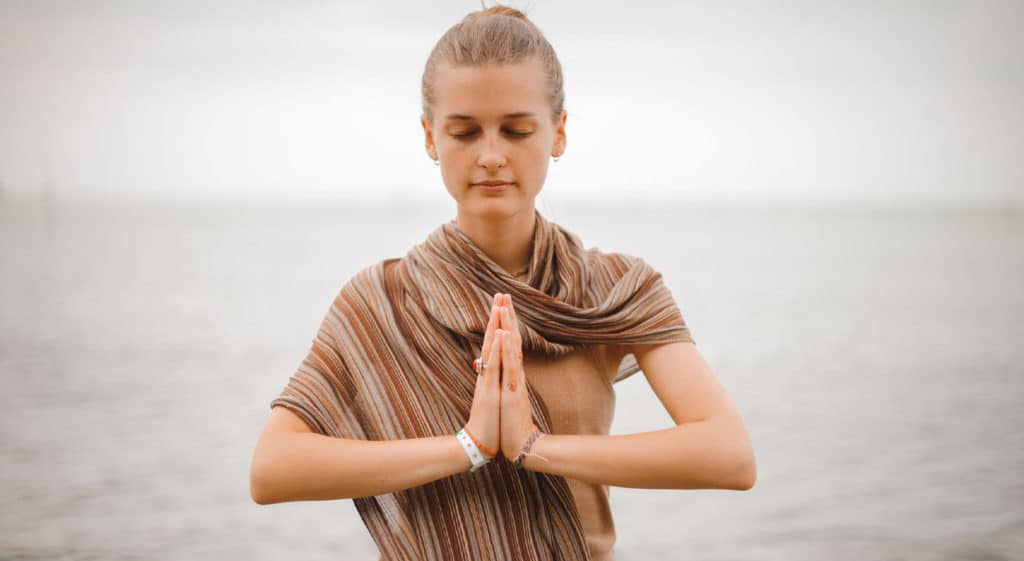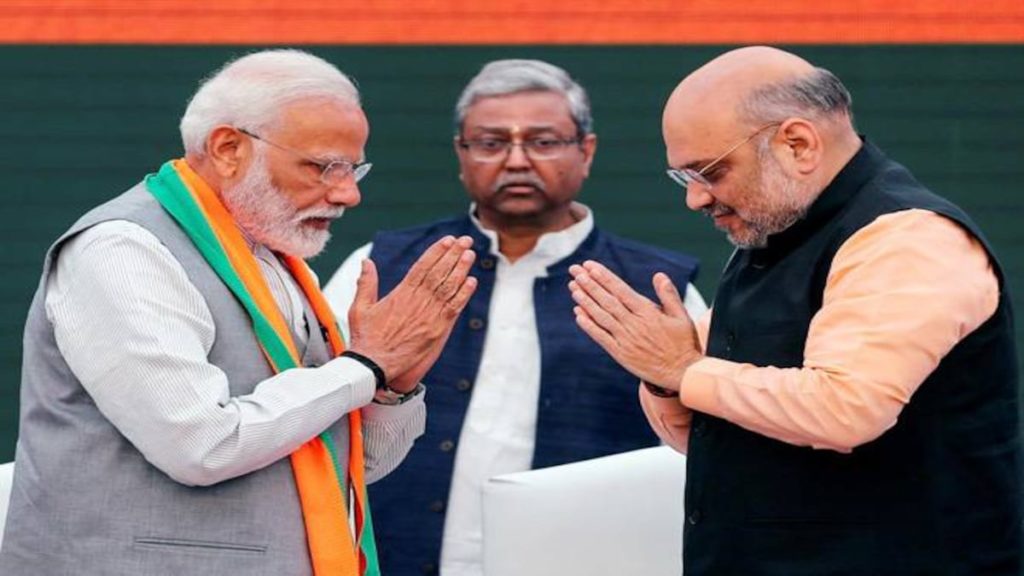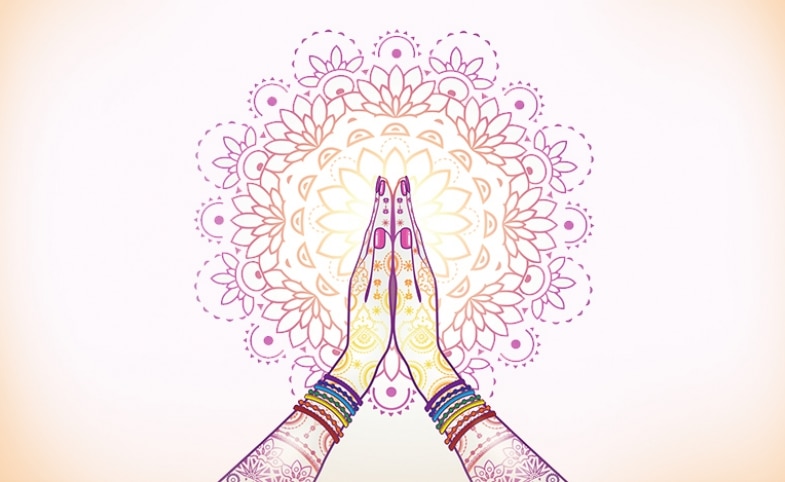The term “namaste” does not have the meaning you might expect in the past. So, what does namaste mean exactly?
Before traveling to India and enrolling in private yoga classes in Rishikesh, I had been practicing yoga on and off in my home country of the United States for several years (read about my experience here). I’ve experimented with a variety of yoga styles and worked with various yoga teachers and studios in a variety of countries. Every yoga class ended with a group Namaste, also known as a salutation.
My yoga instructor in India smiled as I said my final Namaste, and I felt like a complete moron for thinking such a ridiculous thing. Even though it was nonjudgmental, it made me realize that this may not have been the exact context in which the word was used. The gentle nudge to remember was much appreciated.
Table of Contents
Where Did the Phrase “Namaste” Originate?
Namaste is a greeting word in Sanskrit that dates back to the Vedic period. It has Hindu origins and has been in use since antiquity. Even though the term “namaste” has been in use for literally thousands of years and has many different translations and applications, it is, above all, a respectful expression. Yoga and other spiritual practices are becoming more popular in the West. The word Namaste, which originated in the East many centuries ago, is gradually becoming a common expression.
Now that we’ve learned a few of its etymological roots let’s talk about what the word means in everyday situations.
What does the phrase Namaste mean when it refers to the act of bowing?
If you have ever inquired about the meaning of the word Namaste, you are likely to have heard various explanations. There is a wealth of information on the Internet about the significance of Namaste and how to incorporate the “namaste philosophy” into your daily life.

The most common pronunciation is a westernized version of the word (I assume this is the pronunciation that gave rise to the well-known pun Namast’ay In Bed a few years ago). To pay homage to the ancient origins of the yoga practice, we should use the traditional pronunciation whenever possible, even if it is not inherently incorrect.
When you say names, you are expressing your respect for someone or bowing to them. You are expressing admiration or turning to someone when you say “you.” There’s nothing complicated about the literal translation: I bow my head in reverence before you.
Namaste is traditionally expressed with a slight bow and the Ajali Mudra hand gesture, as shown in the image to the right.
In the West and India, the term “Namaste” is used in different ways.
People in the Western world (including myself!) have reported audible shudders when saying the sacred greeting Namaste, which I find strange and unusual. When we first begin practicing yoga, we are taught that the words and gestures we use are part of our ancient yogic heritage and have spiritual significance beyond simply expressing gratitude and respect to our yoga instructors and extending to humanity.
When everyone says Namaste after a yoga class, it feels as if we’re all sharing an important shared secret and revelation about the world (I salute you). The most crucial step toward becoming a better person is to be completely honest with yourself about your flaws
Consider that we all have a divine flame within us, that we are all interconnected, and that we were all created in the Creator’s image.
Some may be surprised to learn that Namaste is commonly used in everyday conversation in India, where it originated and translates as “honor” in the Hindu language. In the United States, you’d say “namaste,” a polite way of greeting someone in India. Namaskar is a less well-known word for salutation that is used as a greeting in India. It comes from the Sanskrit language. The two terms are interchangeable for this discussion.
Maneesh, my Indian yoga teacher, taught me about the concept of respect as part of his explanation of Hindu culture. “Respect is deeply ingrained in Hindu tradition,” Maneesh explained.
According to him, the ancient scriptures emphasize the importance of treating everyone with the same level of respect and hospitality, whether they are senior citizens, family members, or strangers you may have encountered on the street. Maneesh concurs with this assessment.
It is possible to express gratitude to someone and let them know they are welcome in this place of peace by using Namaste and bowing gestures. But, after I embarrassed him by Namaste-ing him at the end of class, Manesh politely explained that he couldn’t think of any links between Namaste and yoga practice on his own.
According to Deepak Singh, a writer of Indian descent, the spiritual significance of Namaste does not appear to be understood by him in the same way that Western yogis do, as he explains in this National Public Radio story about the practice.
Many Indians, I discovered later on discussion forums like Reddit and Quora, do not believe this.
Namaste has been treated in the same way Indian cuisine was by most Western societies: it was taken and tailored to fit the individual tastes of those who participated in it. For example, in the case of Namaste, the pragmatics of the word Namaste has been slightly altered.
We’re unsure where the Namaste that we say at the end of every yoga class came from or why we keep saying it. Unfortunately, no satisfactory answer has been provided to this question until now, which is disappointing. The ability to meditate, on the other hand, is not required for any yoga practice. Apart from that, it is not imported from India to the rest of the world.
Do you greet others with a Namaste, or do you say No Namaste?
You are solely responsible for carrying out this portion of the project.

My advice is to ask yourself why you say Namaste in yoga and then answer that question honestly. What can I say? That seems to be what everyone else does, right? Is this reflective of the fact that you were raised to think in this manner?
Yoga is an excellent tool for personal growth and development. There is nothing incorrect with bowing your head and saying Namaste to your teacher at the end of the day if you feel like it.
Going around the city and greeting people with Namaste (as suggested in this article) might not be a good idea at all. However, suppose you want to spread love and light around the world. In that case, small actions like letting go of the mean girl mentality (a term borrowed from here), being kind and accepting of others, and not being a jerk to others can make a significant difference in the lives of others.
The idea behind the word Namaste and how it is used is both charming and endearing. To function effectively in today’s world, more compassion and a willingness to relate to others are required. Thank you for saying Namaste when it reminds you to be respectful, less toxic, and less judgmental to those in your immediate vicinity, whether they are internet strangers or fellow yoga studio attendees.
When Do You Use the Phrase “Namaste”? Is There a Correct Way to Say Namaste?
What if you want to use the Namaste greeting to express respect for yourself and others but don’t know how? There is no “correct” way to say Namaste, but as long as the words are pronounced correctly, it is acceptable to use them appropriately to express respect and gratitude, regardless of how it is said. A three-syllable word that can be pronounced, among other things, Nah – muh – stay.
When we say Namaste, we usually bow slightly and bring our hands together at the center of our chests in a hand gesture known as the Anjali Mudra, which translates as “to touch the heart.” Muscle-relaxing hand mudras are used in yoga to help us connect with our bodies and minds and advance in our yoga journey. We can connect to the intention of expressing respect and gratitude by using the Anjali Mudra and internalizing the meaning and energy of the phrase “Namaste.”
You can convey the meaning of Namaste without saying the word aloud by using the Anjali Mudra alone or in conjunction with bowing the head. This is shown in the video below.
Even though there is no wrong way to pronounce Namaste, it should not be displayed at all times. Please keep reading to learn when it is appropriate to avoid using the word Namaste in certain situations.
It is acceptable to say “Namaste” in certain situations.
If you are new to yoga, you should be aware that, while Namaste is a standard greeting, you should not feel obligated to use it if it makes you uncomfortable. When it comes to saying Namaste, you may be unprepared, just as your body may be unprepared when it comes to transitioning into a challenging yoga pose. “Thank you,” “I appreciate you,” “I respect you,” and “I honor you” are all different ways of saying the same thing, which is to express gratitude.
It is entirely up to you whether or not incorporating Namaste into your practice and interactions with others makes sense for you. You can effectively communicate your intentions by using nonverbal communication to convey the meaning of Namaste.
Respect yourself by being aware of where you are right now in your life. Because of your experience, you’ll be able to tell when it’s appropriate to say Namaste.
What is the difference between Namaskar and Namaste in terms of meaning?
Some people may have used Namaskar instead of Namaste to express their gratitude. They haven’t wholly mispronounced Namaste because, despite sounding very similar and roughly meaning the same thing, they are used in entirely different ways in different parts of the world.
These two gestures are meant to be salutations to one another and can be used to express greetings or show respect in various situations. In formal situations, the word Namaskar (pronounced “Nuh-muh-skar”) can be used to mean “I pay my respects.” It is also more likely to be used in a group setting rather than an individual setting.
Gesture
Anjali is a revered and worshiped Hindu goddess. In many cultures, the mudra is used in conjunction with the widely recognized greetings Namaste and Namaskar.

Praying hands with faith in religion and belief in God on dark background. Power of hope or love and devotion. Namaste or Namaskar hands gesture.
When in prayer position, the sternum connects the hands (breast bone). The placement of the hands represents a return to one’s innermost being or self. As a result, the comment and gesture complement each other to enhance the layers of meaning within Namaste’s purpose, which is lovely.
In contrast to Westerners, people in India frequently use the Namaste gesture to express their feelings, eliminating the need to say the term aloud in most situations. Instead of simply repeating this phrase over and over, we should consider what it means.
“Namaste,” a lovely word that weaves a thread of connection through our memories of the past, present, and future, tying us to all three points in time.

